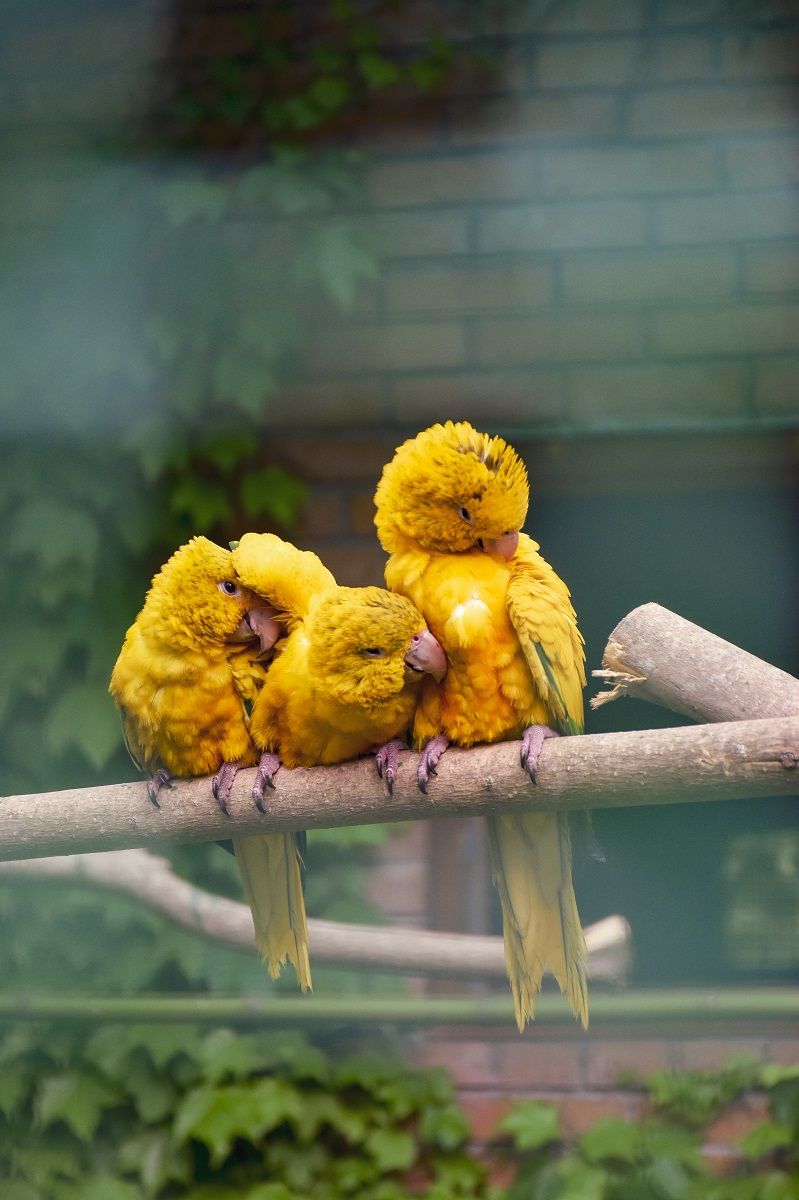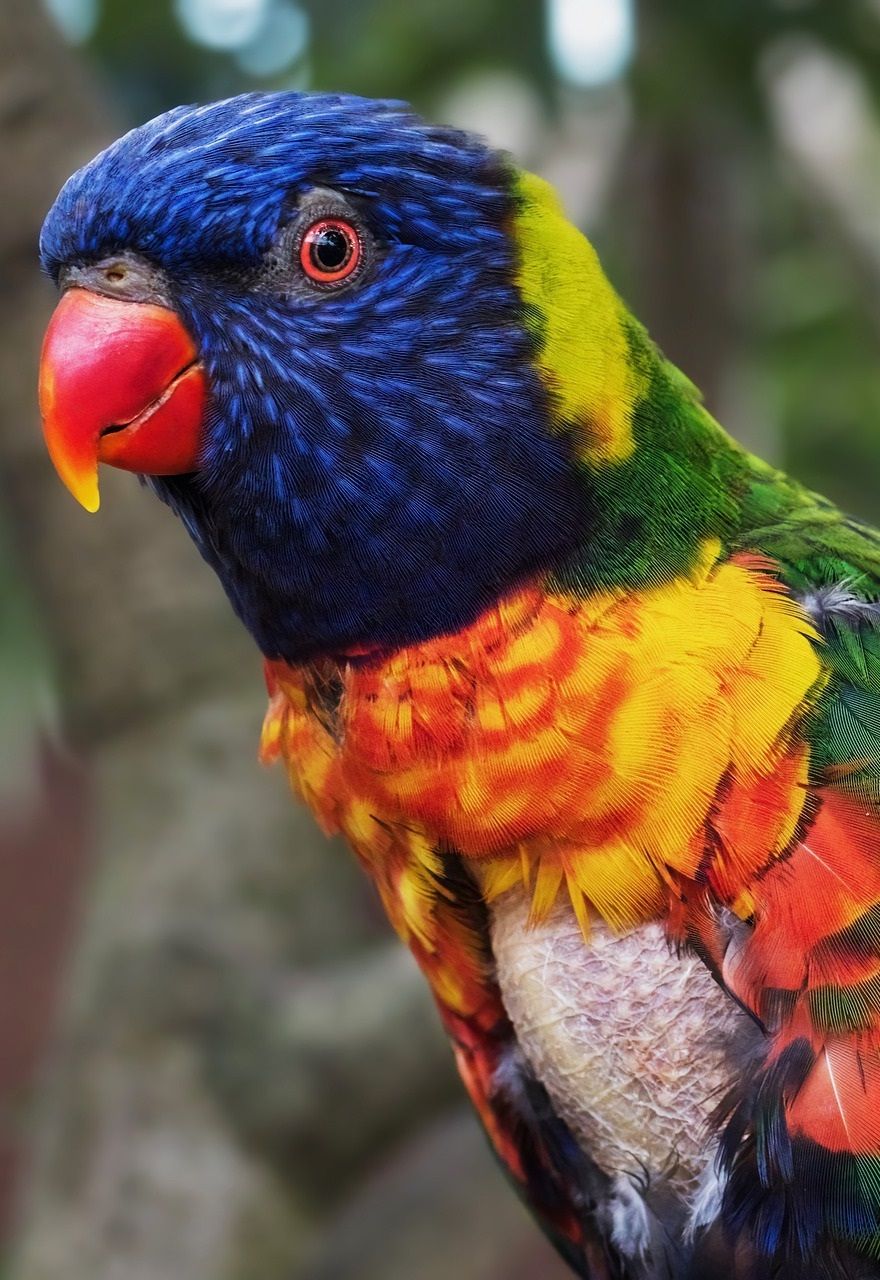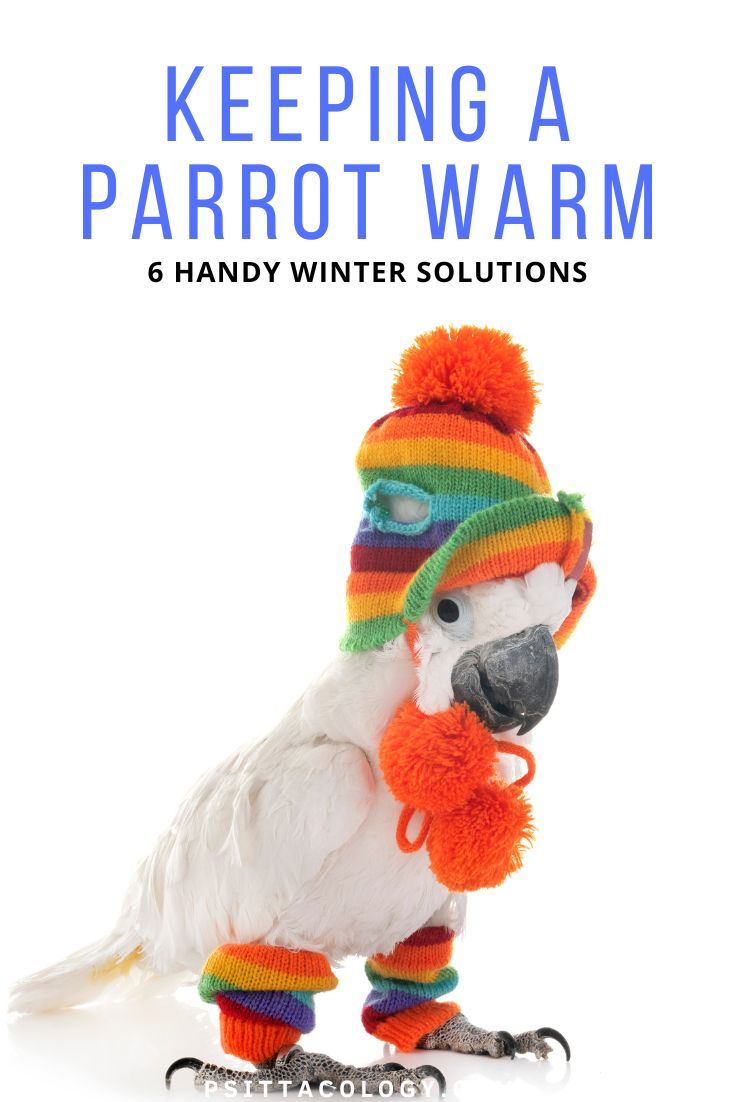Winter is around the corner, and things are bound to get chilly. Even indoors, temperatures can drop a good bit compared to the summer months. We humans can just put on a sweater, but what about our parrots?
Wondering how to keep a parrot warm in winter? Keep reading to find out whether your parrot needs some supplemental heat, plus 6 handy tips on for keeping things nice and toasty throughout the cold season!
This post contains affiliate links. If you make a purchase, a small percentage will go directly to Psittacology at no additional cost to you. Thank you for supporting Psittacology!
Is my parrot cold?
Noticing the temperatures in your home dropping, particularly at night? Whether your parrot is bothered by the cold depends mostly on the species and what it’s used to. They are tropical birds, but their hardiness level varies.
First off, here’s what a parrot looks like when it feels too cold for comfort:
- Fluffed feathers
- Covering its feet with its feathers
- Not moving much
- Tucking its beak into its chest or under its wing
- Shivering
- Eating more
- Pooping less
- Parrots cuddling up together
Most resources recommend not letting the temperature drop below 18.5 °C/65 °F. This is a good rule of thumb to prevent any risk of your parrot getting cold. In reality, though, with many species you’ve got a little more leeway.
Consider: populations of feral Indian ringneck parrots thrive in cities like London (UK) and Utrecht (The Netherlands), where temperatures drop below zero every winter. They likely look for air vents and other warm spots, but still: a slightly chilly home is unlikely to bother them.
The same goes for other hardy species like quaker parrots, which inhabit cities such as Madrid in Spain. Here, the average temperature in January drops to just above freezing, and the birds are as active as ever.
In my home here in southern Spain, where central heating is not a thing and my birds and I can wake up to a chilly 14 °C/57 °F indoor temperature in the dead of winter, I’ve never seen the budgies and cockatiels show signs of being cold. In their natural habitat of central Australia, wintertime night temperatures can drop to freezing.

How to keep a parrot warm: 6 tips
Despite the fact that my birds appear to deal with the cold pretty well, I do still take measures to keep my feathered family warm. To keep your parrot’s health in optimal condition, you should too!
Aside from letting them sit with me for cozy snuggles as often as they want, I use a combination of the methods below to make sure my birds stay comfortable without having to run the heat pump 24/7 and racking up massive bills.
Cage location
Your first step in figuring out how to keep your parrot warm should be to consider the location of its cage. Some folks like to keep their birds outdoors for (part of) summer; if that’s you, it’s obviously time to bring them inside if things are forecast to get chilly.
Aside from this, it’s important to keep your parrot away from drafts and open windows. Unheated spaces like sunrooms or the garage aren’t the best idea either, as the temperature here can drop significantly during nighttime.
A well-isolated spot in the house is best, preferably one that’s kept nice and warm for your own comfort. As you probably don’t run the heating at night, though, you can consider one or multiple of the options below to prevent your parrot from catching a cold while you’re cozied up in bed.
Tip: No fires in the parrot room, please! Although a nice wood fire is incredibly cozy, the smoke is harmful to your bird’s sensitive lungs. Additionally, it goes without saying that an open fireplace and a loose parrot are a highly dangerous combination.

Cage cover
Whether you normally cover the cage at night or not, a nice and thick cover can come in handy if your parrot’s room gets cold at night. It works very well for keeping warm air in and preventing pesky drafts from making your bird sick.
If you have some sewing skills, you can easily DIY a fitted cover for your parrot cage. If you don’t have any sewing skills (like me!), a thick old curtain works fine too. You can also buy universal parrot cage covers for winter.
- ♥♥Birdcage Cover Size♥♥ – Fits cages size up to 18.1″L x 14.1″W x 36.6″H. Suitable for the…
- ♥♥Durable Material♥♥ – Made of Cotton material, non-toxic, breathable, and durable. Allows…
- ♥♥Good Night Bird Cage♥♥ – This bird cage cover blocks most of the sunlight and UV rays and…
Ceramic heat lamp
Folks who keep reptiles have known it for years: ceramic heat lamps are the perfect solution if you need to keep an animal warm. Infrared lamps work as well, but they do emit some light. This isn’t ideal if you want to run some heating throughout the night without keeping your bird awake.
The basic concept of these heat lamps is to use a bulb made of ceramic material. When electricity flows through this ceramic, it heats up, and the heat is radiated outwards. No light is generated.
Because parrots are gonna be parrots, it’s important to use a cover for your ceramic heat bulb to prevent burns. Check the temperature regularly to make sure everything is still in order.
Tip: Make sure you set up the heat lamp on one side of the cage and leave the other side unheated. This way your parrot can choose whether it wants to bask, take a break on the cool side, or sit somewhere in the middle.
- BOEESPAT reptile ceramic heat lamp provides a sleep-friendly solution for reptiles and pets,…
- Crafted from high-purity pottery clay, BOEESPAT ceramic heat emitter is designed to resist cracking…
- Enjoy round-the-clock radiant heat with the reptile heat emitter. Its high-strength ceramic shell…
Heated perch
Because your parrot’s feet aren’t covered in feathers, it loses heat through them quickly. This means that it isn’t actually necessary to heat an entire room: you can make a big difference by just keeping those footsies warm.
Because something like a heated pillow would just get covered in poop and torn apart, heated perches were invented. These look just like normal perches (you can find faux wood, flat and straight ones), but they become lukewarm in order to warm your parrot’s feet without burning them.
I’ve used the thermo-controlled perch by K&H Pet Products myself. My geriatric cockatiel in particular adores it. It has different temperatures throughout the perch so your bird can choose where to sit, and the texture is good for their feet.
- BIRD HEALTH: Heated bird perch counters the effects of cold drafts & air conditioning that can harm…
- GOOD FOR FEET: Unique shape reduces pressure sores and foot cramping; Constructed tough plastic…
- PERFECT TEMPERATURE: Thermostatically controlled with varying temperatures from end to end to allow…
Heat panel
A product often used in conjunction with a heated perch (although it also works fine as a standalone) is a heat panel designed specifically for parrots. The concept is very simple: it’s just a rectangle with a cable that can be attached to the cage bars.
Like heated perches, these panels only become warm, not hot, so there’s no danger to your bird. Install yours next to a perch so they can choose to snuggle right up to it or keep a little more distance.
- PROTECTION: Protect exotic birds from the harmful effects of air conditioning and cold drafts;…
- PERFECT TEMPERATURE: Thermostatically controlled to an optimum body temperature for birds to snuggle…
- LOW VOLTAGE: Uses harmless 12-volt, low voltage electricity to heat the bird warmer and is easy to…
Space heater
Got a big avian family? Buying and running heated perches or heat lamps for all of them might end up leaving you broke.
In situations like these, it may be better to just go for a space heater. They can be safe and don’t necessarily use crazy amounts of power, but it is very important to choose the right type.
Ceramic and oil-filled heaters without PTFE coatings are considered safe as long as the casing doesn’t become hot enough to burn your parrot. You can read more in the post on space heaters for parrots.
Snuggle hut: yes or no?
You may have seen them at your local pet store: snuggly fleece huts for parrots to cozy up in. Did you know that these are one of the most controversial parrot products out there?
Although these hammocks (also called happy huts) are great for keeping a parrot warm, they are similar to the tree hollows our birds naturally use for nesting. As a result, they can provoke strong hormonal and nesty reactions in some parrots.
Aside from this, a major problem is that a lot of parrots end up chewing their snuggle hut. The fibers can’t be digested and get stuck in their crop, which in extreme cases can lead to fatal issues.
Additionally, a parrot’s foot or nail can easily get stuck in a newly chewed thread. If it panics and starts thrashing around, this can cause serious injuries.
So should you get your parrot a snuggle hut to help keep it warm? Well, you can try. If it’s not prone to getting broody or hormonal and doesn’t tend to chew on things, it might work. Monitor closely and remove the hut if you think your bird is chewing it.

Frequently asked questions
Yes. Like humans, parrots are warm-blooded.
The general rule of thumb is 18.5 °C/65 °F as a minimum. Although your parrot can likely handle a bit cooler just fine, if you prefer being safe rather than sorry, try to keep the temperature around or above this.
If you have any more questions about how to keep a parrot warm or if you want to share your own experiences, don’t hesitate to leave a comment below!




